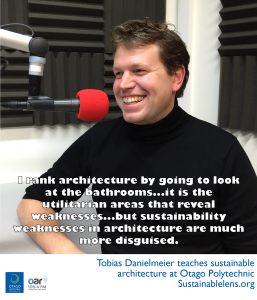I rank architecture by going to look at the bathrooms…it is the utilitarian areas that reveal weaknesses…but sustainability weaknesses in architecture are much more disguised.
Tobias Danielmeier teaches and researches sustainable architecture in the School of Design at Otago Polytechnic. He was instrumental in the First Light House – the first Southern Hemisphere entry into the Solar Decathlon. He is also interested in performative architecture – a combination of how a building works functionally and in telling stories.
Talking points
I rank architecture by going to look at the bathroom…it is the utilitarian areas that reveal weaknesses…but sustainability weaknesses in architecture are much more disguised.
There is ideally a marriage of people and place – how the building sits in within its environment.
We’ve seen a shift in how students treat sustainability. For a long time now they have been driven to change the world, then this changed as they saw the problems as too big, we can’t tackle them; the changed again, but now this is changing back again to more inspirational values – we can make a difference.
Connecting with regional experiences, authentic experiences..craft beers, regional cuisines…this is what I mean by post consumerism architecture.
(Activist?) Passive activist. Opening minds of young people.
(Motivation?) Good architecture – striving for better tomorrows.
(Smallest thing that would make the biggest impact?) Better public transport – different ways of achieving the 1/4 acre dream. Not compromising on luxuries, but achieving them in different ways.
(Advice for listeners?) Investigate localised energy production. Try to become energy independent.

